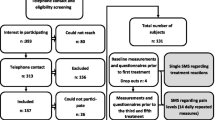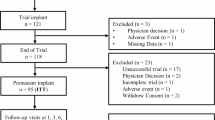Abstract
This aim of this study was to determine the effect of different conservative treatment methods on pain intensity, disability, quality of life, and mood in patients with cervical spondylosis during a 6-month period. The patients were randomized into three groups. The 1st group (n = 20) was treated with active and passive physiotherapy methods, the 2nd group (n = 20) with active treatment methods, and the 3rd group (n = 20) with medication, including nonsteroid anti-inflammatory and muscle relaxing medicines. The 1st and 2nd groups received individual exercise treatment according to their current problems as determined by the assessment. Pain recovery was found to be statistically significant after treatment and long-term follow-up for all three groups (P < 0.05). Disability improvement was significant in all groups after treatment and 3rd months and only in 1st group after 6 months (P < 0.05). Quality of life improvement was significant in all groups after treatment, at 3 months, and in the 1st and 2nd groups at 6 months (P < 0.05). Psychological recovery was significant in all groups after treatment and in the 1st and 2nd groups during long-term follow-up (P < 0.05). It was determined that patient satisfaction did not change in the 1st and 2nd group (P > 0.05), but decreased in the 3rd group (P < 0.05) during long-term follow-up. There was more improvement in the two groups receiving exercise treatment than the group receiving medical treatment. In conclusion, exercise treatment has an important role in achieving long-term recovery of problems occurring with cervical spondylosis.
Similar content being viewed by others
Explore related subjects
Discover the latest articles and news from researchers in related subjects, suggested using machine learning.References
Wieser ES, Wang JC (2007) Surgery for neck pain. Neurosurgery 60(Suppl 1):51–56
Pierre C, David CJ, Linda C (1998) The Saskatchewan health and back pain survey: the prevalence of neck pain and related disability in Saskatchewan adults. Spine 23(15):1689–1698
Borenstein DG, Wiesel SW, Boden SD (2004) Low back and neck pain: comprehensive diagnosis and management, 3rd edn. Saunders, Philadelphia
Wang WTJ, Olson SL, Campbell AH, Hanten WP, Gleeson PB (2003) Effectiveness of physical therapy for patients with neck pain an individualized approach using a clinical decision-making algorithm. Am J Phys Med Rehabil 82(3):203–218
Abbed KM, Coumans JV (2007) Cervical radiculopathy: pathophysiology, presentation, and clinical evaluation. Neurosurgery (1 Suppl1 1): 28–34 Review. doi:10.1227/01.NEU.0000249223.51871.C2
Hoving JL, Koes BW, de Vet HCW, van der Windt DAWM, Assendelft WJJ, van Mameren H et al (2002) Manual therapy, physical therapy, or continued care by a general practitioner for patients with neck pain. A randomized, controlled trial. Ann Intern Med 136(10):713–722
Giles LGF, Muller R (2003) Chronic spinal pain: a randomized clinical trial comparing medication, acupuncture, and spinal manipulation. Spine 28(14):1490–1503
Haraldson BG, Gross AR, Myers CD, Ezzo JM, Morien A, Goldsmith C, Peloso PM, Bronfort G (2006) Massage for mechanical neck disorders. Cochrane Database Syst Rev CD004871. doi:10.1002/14651858.CD004871.pub3
Kroeling P, Gross AR, Goldsmith CH (2005) A Cochrane review of electrotherapy for mechanical neck disorders. Spine 30(21):641–648
Bronfort G, Evans R, Nelson B, Aker PD, Goldsmith CH, Vernon H (2001) A randomized clinical trial of exercise and spinal manipulation for patients with chronic neck pain. Spine 26(7):788–799
Chiu TTW, Hui-Chan CWY, Cheing G (2005) A randomized clinical trial of TENS and exercise for patients with chronic neck pain. Clin Rehabil 19:850–860
Sarig-Bahat H (2003) Evidence for exercise therapy in mechanical neck disorders. Man Ther 8(1):10–20
Descarreaux M, Normand MC, Laurencelle L, Dugas C (2002) Evaluation of a specific home exercise program for low back pain. J Manipulative Physiol Ther 25:497–503
Beebe FA, Barkin RL, Barkin S (2005) A clinical and pharmacologic review of skeletal muscle relaxants for musculoskeletal conditions. Am J Ther 12:151–171
van Tulder M, Koes B, Bouter LM (1997) Conservative treatment of acute and chronic nonspecific low back pain: a systematic review of randomized controlled trials of the most common interventions. Spine 22(18):2128–2156
Douglass AB, Bope ET (2004) Evaluation and treatment of posterior neck pain in family practice. J Am Board Fam Pract 17:13–22
Peloso P, Gross A, Haines T, Trinh K, Goldsmith CH, Burnie S (2007) Medicinal and injection therapies for mechanical neck disorders. Cochrane Database Syst Rev CD000319. doi:10.1002/14651858.CD000319.pub4
Korthals-de Bos IBC, Hoving JL, van Tulder MW, Rutten-van Mölken MPMH, Adèr HJ, Vet HCW et al (2003) Cost effectiveness of physiotherapy, manual therapy, and general practitioner care for neck pain: economic evaluation alongside a randomized controlled trial. BMJ 326(7395):911
Evans R, Bronfort G, Bittell S, Anderson AV (2003) A pilot study for a randomized clinical trial assessing chiropractic care, medical care, and self-care education for acute and subacute neck pain patients. J Manipulative Physiol Ther 26:403–411
Birch S, Jamison R (1998) Controlled trial of Japanese acupuncture for chronic myofascial neck pain: Assessment of specific and nonspecific effects of treatment. Clin J Pain 14(3):248–255
Pesco MS, Chosa E, Tajima N (2006) Comparative study of hands-on therapy with active exercises vs education with active exercises for the management of upper back pain. J Manipulative Physiol Ther 29:228–235
Jordan A, Bendix T, Nielsen H, Hansen FR, Host D, Winkel A (1998) Intensive training, physiotherapy, or manipulation for patients with chronic neck pain. A Prospective, Single-Blinded, Randomized Clinical Trial. Spine 23(3):311–319
Chiu TT, Lam TH, Hedley AJ (2005) A randomized controlled trial on the efficacy of exercise for patients with chronic neck pain. Spine 30(1):E1–E7. doi:10.1097/01.brs.0000149082.68262.b1
Berg HE, Berggren G, Tesch PA (1994) Dynamic neck strength training effect on pain and function. Arch Phys Med Rehabil 75:661–665
Telci EA, Karaduman A, Yakut Y, Aras B, Simsek IE, Yagli N (2009) The cultural adaptation, reliability, and validity of neck disability index in patients with neck pain: a Turkish version study. Spine 34(16):1732–1735
Vernon H, Mior S (1991) The neck disability index: a study of reliability and validity. J Manipulative Physiol Ther 14(7):409–415
Küçükdeveci AA, Mckenna SP, Kutlay S, Gürsel Y, Whalley D, Arasıl T (2000) The development and psychometric assessment of the Turkish version of Nottingham health profile. Int J Rehabil Res 23:31–38
Savaşır I, Şahin NH (1997) Bilişsel-davranışçı terapilerde değerlendirme: Sık kullanılan ölçekler. Özyurt Matbaacılık, Ankara
Cherkin D, Wheeler K, Barlow W, Deyo R (1998) Medication use for low back pain in primary care (health services research). Spine 23(5):607–614
Vos C, Verhagen A, Passchier J, Koes B (2007) Management of acute neck pain in general practice: a prospective study. Br J Gen Pract 57(534):23–28
Hoiriis KT, Pfleger B, McDuffie FC, Cotsonis G, Elsangak O, Hinson R et al (2004) A randomized clinical trial comparing chiropractic adjustments to muscle relaxants for low back pain. J Manipulative Physiol Ther 27(6):388–398
Ketenci A, Özcan E, Karamürsel S (2005) Assessment of efficacy and psychomotor performances of thiocolcicoside and tizanidine in patients with acute low back pain. Int J Clin Pract 59(7):764–770
Koes BW, Scholten RJMP, Mens JMA, Bouter LM (1997) Efficacy of non-steroidal anti-inflammatory drugs for low back pain: a systematic review of randomized clinical trials. Ann Rheum Dis 56:214–223
Coˆte′ P, Cassidy D, Carroll L (2000) The factors associated with neck pain and its related disability in the Saskatchewan population. Spine 25(9):1109–1117
Nikander R, Mälkia E, Parkkari J, Heinonen A, Starck H, Ylinen J (2006) Dose- response relationship of specific training to reduce chronic neck pain and disability. Med Sci Sports Exerc 38(12):2068–2074
Viljanen M, Malmivaara A, Uitti J, Rinne M, Palmroos P, Laippala P (2003) Effectiveness of dynamic muscle training, relaxation training, or ordinary activity for chronic neck pain: randomized controlled trial. BMJ 327(7413):475
Jull G, Trott P, Potter H, Zito G, Manip GD, Niere K et al (2002) A randomized controlled trial of exercises and manipulative therapy for cervicogenic headache. Spine 27(17):1835–1843
Pallay RM, Seger W, Adler JL, Ettlinger RE, Quaidoo EA, Lipetz R et al (2004) Etoricoxib reduced pain and disability and improved quality of life in patients with chronic low back pain: a 3 month, randomized, controlled trial. Scand J Rheumatol 33:257–266
Ask T, Strand KI, Skouen JST (2009) The effect of two exercise regimes; motor control versus endurance/strength training for patients with whiplash associated disorders: a randomized controlled pilot study. Clin Rehabil 23:812–823
Buchner M, Zahlten-Hinguranage A, Schiltenwolf M, Neubauer E (2006) Therapy outcome after multidisciplinary treatment for chronic neck and chronic low back pain: a prospective clinical study in 365 patients. Scand J Rheumatol 35(5):363–367
Salo PK, Häkkinen AJ, Kautiainen H, Ylinen JJ (2010) Effect of neck strength training on health-related quality of life in females with chronic neck pain: a randomized controlled 1-year follow-up study. Health Qual Life Outcomes 8:48
Cunha ACV, Burke TN, França FJR, Marques AP (2008) Effect of global posture reeducation and of static stretching on pain, range of motion, and quality of life in women with chronic neck pain: a randomized clinical trial. Clinics 63(6):763–770
Linton SJ (2000) A review of psychological risk factors in back and neck pain. Spine 25(9):1148–1156
Holmberg SAC, Thelin AG (2006) Primary care consultation, hospital admission, sick leave and disability pension owing to neck and low back pain: a 12-year prospective cohort study in a rural population. BMC Musculoskelet Disord 14(7):66
Demyttenaere K, Bruffaerts R, Lee S, Posada-Villa J, Kovess V, Angermeyer MC et al (2007) Mental disorders among persons with chronic back or neck pain: results from the world mental health surveys. Pain 129:332–342. doi:10.1016/j.pain.2007.01.022
Blozik E, Lapinskaya D, Herrmann-Lingen C, Schaefer H, Kochen MM, Himmel W, et al. (2009) Depression and anxiety as major determinants of neck pain: a cross-sectional study in general practice. BMC Musculoskelet Disord 26; 10:13
Taimela S, Takala EP, Asklöf T, Seppälä K, Parviainen S (2000) Active treatment of chronic neck pain. A prospective randomized intervention. Spine 25(8):1021–1027
Hills R, Kitchen S (2007) Satisfaction with outpatient physiotherapy: focus groups to explore the views of patients with acute and chronic musculoskeletal conditions. Physiother Theory Pract 23(1):1–20
Acknowledgments
The authors thank Dr. Erkan Sumer for writing out prescriptions of our patients in medicine group.
Author information
Authors and Affiliations
Corresponding author
Rights and permissions
About this article
Cite this article
Aslan Telci, E., Karaduman, A. Effects of three different conservative treatments on pain, disability, quality of life, and mood in patients with cervical spondylosis. Rheumatol Int 32, 1033–1040 (2012). https://doi.org/10.1007/s00296-010-1751-4
Received:
Accepted:
Published:
Issue Date:
DOI: https://doi.org/10.1007/s00296-010-1751-4




